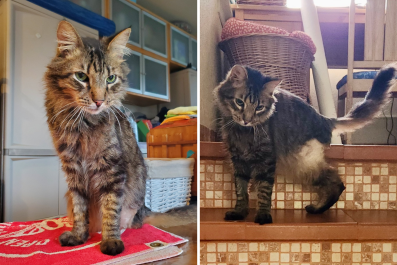
Senior Cat Neglected for 7 Years Looking for New Home After Amputation
A three-legged cat is looking for a place to call home after a rough start to life that led to an amputation.
Long John Silver, a gray tabby, was one of 52 cats rescued from a hoarder's home. He was in "terrible condition" when he was taken to Friends of the Alameda Animal Shelter (FAAS) in California.
He required immediate medical attention, which included the removal of his left rear leg and the extraction of seven teeth. Despite this, he hasn't lost his faith in humanity and is described as a friendly and sweet cat by his foster parents.
Newsweek spoke to the shelter's communications manager, Maria Goodavage, who would love nothing more than to find the seven-year-old a home before Christmas.

Goodavage said: "From the minute he got back to his fosters from surgery, he was getting around incredibly well, considering he'd just lost a leg. His mental and physical resilience astounds his fosters.
"He seems unfazed and gets around from the floor to the bed to the top of a bookshelf as if nothing happened. He limps when he walks but gets around without issue."
For many cats in hoarding situations, dental disease is a common and often painful condition, sometimes preventing them from eating and causing further harm, explained Goodavage.
Hoarding typically involves accumulating animals, neglecting their basic needs, and denying their poor living conditions. Animals suffer from overcrowding, malnutrition, and disease, often leading to death or euthanasia, according to People for the Ethical Treatment of Animals (PETA).
Experts agree that hoarding typically involves three behaviors: accumulating a large number of animals, failing to meet their basic needs (food, water, shelter, veterinary care), and denying or excusing the appalling living conditions.
This leads to filthy, overcrowded environments where animals suffer from malnutrition, poor health, and disease. Many are confined to small cages and exposed to hazardous conditions like ammonia buildup from waste. Some animals may even resort to cannibalism. The majority of hoarded animals die due to neglect or must be euthanized because of severe physical and mental trauma.

Animal hoarders, once seen as overwhelmed individuals, are now recognized as people whose mental health issues lead to harmful and criminal behavior with devastating effects on animals and their communities.
Long John, also referred to as LJ, has proved to be a true fighter, unwilling to let his past define him.
His fosterer, Babs Kenney, added: "From day one, he has been such a friendly cat. He has never hidden once and loves to be pet."
Goodavage told Newsweek: "He gets on well with the other cats, though he's sort of a loner, enjoying his time with humans more. He currently shares a home with little dogs, but they don't pay him much attention, and vice versa."
Do you have funny and adorable videos or pictures of your pet you want to share? Send them to life@newsweek.com with some details about your best friend and they could appear in our Pet of the Week lineup.
